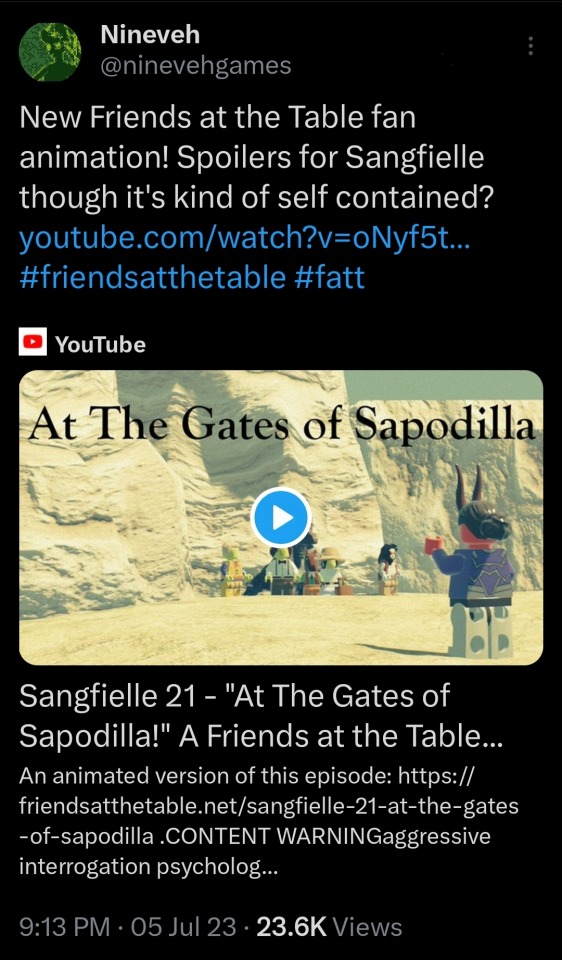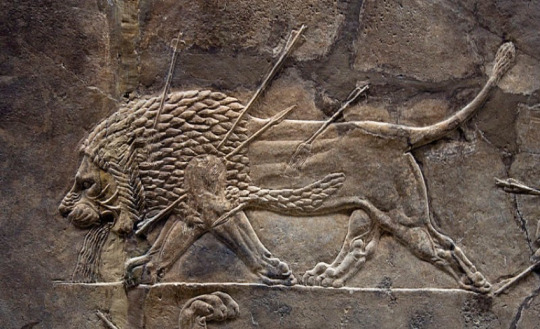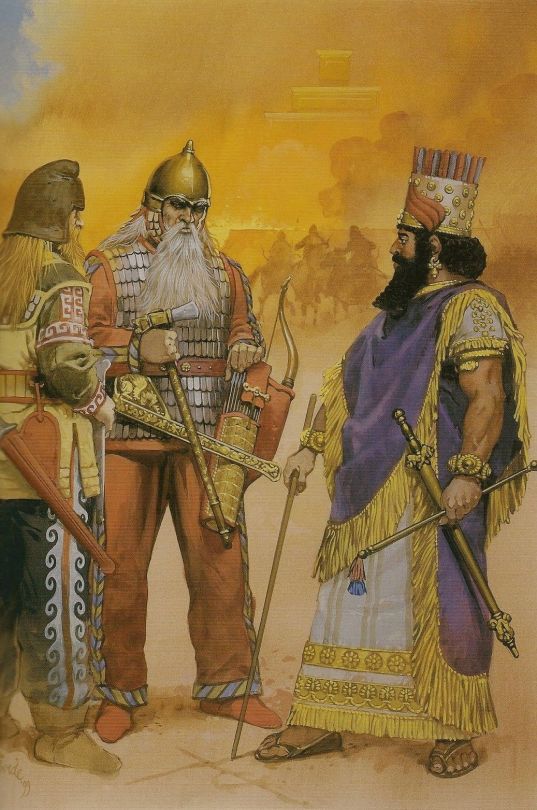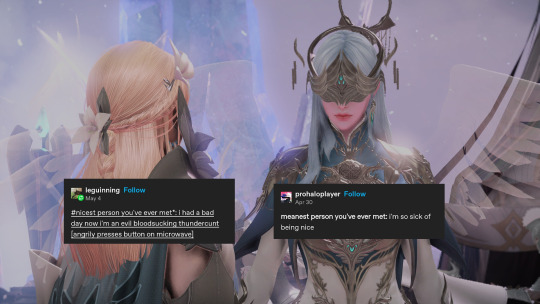#Nineveh
Text

01/19/2024
...but I am okay with that now.
___
JOKE-OGRAPHY:
1. Jonah is the guy who got eaten by a fish. Classic story. He was a prophet, but one day God gave him a mission he didn't want to take. The city of Nineveh was being evil, and God wanted Jonah to tell them to stop. Out of fear, Jonah instead hitched a ride on a boat headed in the other direction. As the boat sailed, however, a storm appeared. The sailors all assumed God was angry at Jonah, so they tossed him overboard and the storm ended. Before Jonah drowned, God sent a giant fish to swallow him and keep him alive. While stuck inside the fish, Jonah apologized to God for running away, and after that, the fish vomited Jonah up on the shore, and Jonah went to Nineveh and warned the people. To his surprise, the people listened and changed their ways.
2. In this cartoon, Jonah warns the people of Nineveh to change their ways before God destroys them. He lists a few ways God might exact His justice upon the city. The last thing he mentions -- the fish thing -- sounds a little out of place as a punishment for a whole city. That's because the fish thing is actually the way God acted His justice upon Jonah only a short time before he came to Nineveh. Jonah is still a little bitter.
#catholic#christian#jesus#comic#cartoon#catholic memes#jesus memes#christian memes#tomics#bible#jonah#nineveh#prophet#repent said the prophet#to sink or swim
457 notes
·
View notes
Text

Judith holding the Head of Holofernes by Jean-François Godefroy
#judith#holofernes#art#jean françois godefroy#judith and holofernes#biblical#bible#assyrian#assyria#general#book of judith#bethulia#siege#war#camp#tent#city#religion#religious art#christianity#christian#jewish#nineveh#nebuchadnezzar#mesopotamia#mesopotamian#sword#helmet#shield#heroine
84 notes
·
View notes
Text

Great Mosque, Mosul, IRAQ
28 notes
·
View notes
Text

snuck in one art during revision
#after midterms i want to try to give out portraits to anyone who buys from hirbawi or donates directly to a palestinian person/org#my art#nineveh
62 notes
·
View notes
Text

Very very enamoring commission I got from @maturiin , based off writing between me and @haonqq
#He did such a killer job catching the mood I am sooo SOO#thee colors the used the color Nineveh? His legs#his little demon feets#aggh#AND TEDDI'S FACE!!#AGH#I AM more than likely going to reblog this again later with the chunk of text its made for because aGh#it's so fitting..#Theodore Thorne#Nineveh#im bouncing around slightly rabid
28 notes
·
View notes
Text
Archaeologists unearth a monumental lamassu in ancient Khursbad, Iraq; an Assyrian deity with a human head, bird wings, and a lion/bull body.
42 notes
·
View notes
Text


Friends at the Table Retweeted
austin walker @/austin_walker, quote retweeting Nineveh:
This is SO good. For people who haven't heard the full @Friends_Table episode w/ the setup and explanation, we used Inhuman Conditions (a game inspired by Blade Runner's Voight-Kampff test) to play out a series of (anti-)occult border crossing/immigration interviews.
8:38 AM PDT, 06 July 2023 (Source)
Nineveh @/ninevehgames (@ninevehgames)
New Friends at the Table fan animation! Spoilers for Sangfielle though it's kind of self contained? youtube.com/watch?v=oNyf5t4soCQ #friendsatthetable #fatt
youtube
Sangfielle 21 - "At The Gates of Sapodilla!" A Friends at the Table Fan Animation
An animated version of this episode: https://friendsatthetable.net/sangfielle-21-at-the-gates-of-sapodilla
CONTENT WARNING
aggressive interrogation...
9:13 AM PDT, 05 July 2023 (Source)
72 notes
·
View notes
Text





Nineveh in Lost Ark - Paradise of the Dreamless
67 notes
·
View notes
Text
Assyrian Royal Lion Hunt: Dying Lion and Lioness


From the reliefs of the palace of Ashurbanipal, the last eminent Assyrian King, at Nineveh.
About 20 years after the death of Ashurbanipal the once so mighty Assyria herself was in her death throes, as the Assyrian heartland and eventually the royal capital of Nineveh were devastated by the armies of the alliance of Babylon with the Medes.
17 notes
·
View notes
Text

Nabopolassar, king of Babylon, and the king of Scythia at the fall of Nineveh, 612 BCE by Angus McBride
"The Scythians make their first major appearance in the fertile crescent during the 7th and 6th centuries BCE. It is during this time that the nomadic horse archers engage the region’s strongest power up to that date, the Neo Assyrian Empire under Esarhaddon. Presumably, after the Scythians engaged and defeated the Assyrians in a skirmish, Esarhaddon agreed to marry his daughter to the Scythian Chieftain Partatua (whose name meant "with far-reaching strength.") Bartatua was the successor of the previous Scythian king, Išpakaia, and might have been his son. After Išpakaia had attacked the Neo-Assyrian Empire and died in battle against the Assyrian king Esarhaddon around 676 BCE, Bartatua succeeded him. After this event, the Scythians continued to engage in continuous raids throughout the Near East, from Palestine to Egypt. Eventually, the Scythians took part in the biblical event that was the end of the Neo Assyrian Empire, contributing to the sack of Nineveh.
Both in terms of culture and military, the Scythians would have been a shock to the major powers of the time, the Babylonians and Assyrians. Being a series of tribal confederations rather than a concrete nation with cities, any form of retaliation against the Scythians would be nearly impossible (as Cyrus the Great would later find out). The Scythians, being nomads, would attack swiftly with their infamous horse archers, using well-crafted composite bows. The Scythians would then finish the job with heavy cavalry covered in metal scales, which would no doubt be a shock to the Semitic peoples of the Middle East, used to encountering heavy infantry, archers and chariots of Assyria and Egypt.
The presence of women within Scythian society would have been even more of a shock to the states of the Middle East. The Scythians, and particularly their relatives, Sarmatians were famous for their fierce warrior women. In Scythian armies, women were expected to fight alongside their men on horseback. This gave rise to the mythological “Amazons” who indeed had a basis in historical reality. Archaeology confirms this, as many Scythian women are buried with weapons.
The Scythians also took part in the greater economic cultural exchange of the Middle East. Besides trading their prestigious bows, Scythian art appears to be found in Middle Eastern cities such as Urartu and Middle Eastern bowls and jewelry appear in Scythian graves as well. It is even theorized that after seeing Middle Eastern art, the Scythians blended it with their own art style, resulting in the Scythian “animal style” of art, for which the Scythians are famous. The Middle Eastern art adopted by the Scythians would then be spread all over the Middle East and Europe as well. Imagery depicting animals and the hunting of various beasts is thought to have been a product of this cultural exchange, adding to the brilliant craftsmanship of the Scythians."
-taken from arabamerica and wikipedia
#scythian#nabopolassar#art#babylonian#nineveh#assyrian#ancient history#history#pagan#paganism#angus mcbride#7th century bce
221 notes
·
View notes
Text
Fucking hell.
Poor buggers.
The Iraqi govt is doing precisely nothing for these people (Yazidis (also Assyrians))
They don’t give a shit!
Reblog the shit out of this.
#dougie rambles#vent post#political crap#mesopotamia#iraq#middle east#Asia#assyria#bethnahrin#nineveh#yazidi#yazidis#yezidi#exhumation#mass graves#fuck isis#terorism#war crimes#genocide#reblog this#reblog the shit out of this#indigenous#indigenous people#Yazda
20 notes
·
View notes
Text

The 74th genocide the Yazidi lived through was in 2014. It was several more years before I arrived in Iraq to help in any small way I could. When I went, ISIS was still in Mosul, Trump was still president, we never knew what caused the smoke on the Syrian border as we drove by, and I was afraid I wouldn't make it back into the country when the Muslim ban was debated.
The village elders I met in Sinjar thought my American status meant I could raise attention internationally, but all I had were words no one would listen to.
Now I have an audience, a very, very small one, but I made a promise to use my words and I am doing so to the best of my ability. If you can help, please get in touch with me.
Their website is still in the development stages but I can connect you with the director or other useful figures. Longer story under the cut.
On August 3, 2014, ISIS attacked the Sinjar region (and I'm using Americanized names for familiarity's sake) in Nineveh, in northern Iraq. The few who were able to get warning from nearby villages piled into their cars and drove as far up the mountain as their cars could take them. One girl, I believe she was ten, was unable to hold onto the side of her father's truck. He could stop and save her, or continue and save the rest of their family. He continued on, and this organization is named Yuva in her memory. No one knows which horror she encountered.
The next day, the now-director of Yuva began attempting to distract the children from their terror, their hunger, their grief, by starting impromptu lessons. These continued as the Yazidi were trapped on the mountain, the young and old dying from thirst, starvation, and exposure to the elements. Some of the women who escaped finding their own ends as well.
But my friend, a truly incredible person, my own age, didn't stop when they returned to their decimated homes. Throughout the rebuilding process, which was still underway when I arrived several years later, he began formal classes in buildings that were not too damaged, like the school had been. He had volunteers I worked with, and focused those early days on teaching children English. He wanted them to be able to leave Iraq, something very, very few have been able to do.
He now runs Yuva, an international NGO funded by the UN, and they have built schools over the rubble, found qualified teachers, and are still going strong.
I'm not rich. I'm not famous. But I have a small number of people who listen to what I have to say, and which I've said in my chapbook (shout out to And My Blood Sang because you know I gotta), I will use my voice as much as I am able. I promised I would do that. And even if I hadn't, it's the least I can do.
These people who lost everything took me in with kindness and promised to protect me. They didn't shame my naivety, I think in part because they hoped that if one optimistic girl could come and try to change things, even if they had to save her at checkpoints and adjust to having a woman in the many councils of men, maybe there could be more. I hope there will be.
If you read this far, thank you. Being in Iraq changed my entire life, and I will not stop fighting for the forgotten.
14 notes
·
View notes
Photo

Face of a Colossal Figure from Nineveh
This carved stone face probably belonged to a head of a sphinx. The Assyrian king Sennacherib ordered several colossal statues to be made in his new palace. Such giant statues were thought to have a supra-natural protective power. From the south-west palace at Nineveh (modern Ninawa Governorate, Iraq), northern Mesopotamia. 700-695 BCE. (The British Museum).
129 notes
·
View notes
Photo






Elgacia was SICK so have some more text posts
#lost ark#lost ark mmo#lauriel#lauriel lost ark#azakiel#azakiel lost ark#prunya#prunya lost ark#nineveh#nineveh lost ark#my posts
17 notes
·
View notes
Text
Such beautiful reliefs. The Mesopotamian artists were as stylised as any in the Ancient Near East, and had as fine craftsmanship as the Egyptians and the Hittites.
55 notes
·
View notes
Text



tfw you get to write the charcter hurty scenes youve had in mind for maybe multiple months
42 notes
·
View notes